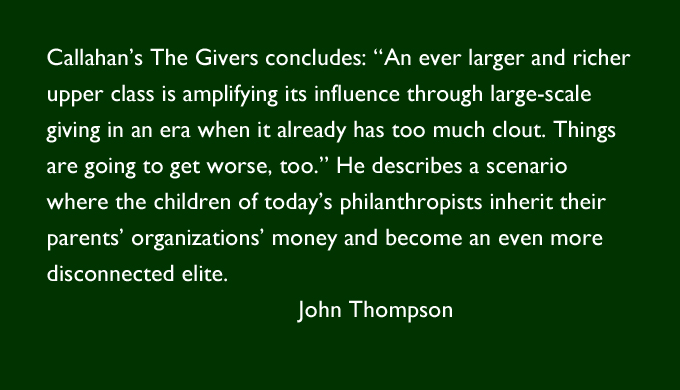By John Thompson.
David Callahan’s The Givers begins with the first politicized think tanks of the 1960s and 1970s, such as the American Enterprise Institute. Callahan may be right and the AEI may have been one of the more intellectually honest of the conservative alternatives to academic research, but still it didn’t abide by the rules of evidence that apply in universities. These first generation think tanks were designed to “excel at framing the terms of public debates” and to “wage big-picture ideological warfare.”
The rise of Silicon Valley prompted the growth of what ProPublica’s Jesse Eisenberg called “a society of oligarchs.” I used to think it is an exaggeration to speak of “new Silicon Valley overlords.” After all, the tech world is collaborative as well as competitive.
Besides, as a pro-choice lobbyist, I had personal experience with the care with which the reproductive rights movement, at least, took to obey the spirit and the letter of the laws regulating charitable organizations. We took special care to ensure that it was our 501(c)(4) non-tax exempt organization, not the 501(c)(3), that engaged in political action. I had no idea that the IRS would allow the shenanigans recently documented by the Washington Post.
The Post’s Robert O’Harrow Jr. and Shawn Boburg document the efforts by Donors Capital Fund, Donors Trust, the Bradley Foundation, the Scaife family, and David Horowitz’s Freedom Center as they “financed nonprofit organizations that promoted free enterprise and small government and opposed the environmental movement and other issues favored by progressives.” They also paved the way for the election of Donald Trump. Big donors used tax exempt charities to create what Horowitz dubbed, “a shadow political universe.”
But those are rightwingers. Surely more progressive and neoliberal donors would respect the rule of law and the principles of our democracy….
Callahan’s new book, along with other research, further documents the overreach of the “Billionaires Boys Club” which funds corporate school reform. The Gates, Broad, and Walton foundations have been cavalier about the line separating charitable versus unabashed political giving but, in theory, the damage they have done could be primarily attributed to hubris.
Callahan explains how
…the heavy-handedness of K-12 funders in recent years has offered a showcase of big philanthropy’s dark side. Their grandiose plans have often failed to anticipate realities on the ground, created intense polarization.
However, big philanthropy responded to policy failures by blaming and demonizing teachers, unions, and their other opponents. It invested even more in “astroturf” think tanks and “citizen” groups, to generate buzz and “momentum.” As Callahan says, Gates is just one of the elites who are doubling down on “orchestrating public conversations.” Now, it is clear that “givers with deeper pockets bankroll think tanks that have the ear of top officials.” This exemplifies the “expansion of the kind of sophisticated elite power that so many Americans find unnerving”
Callahan closes one of his best chapters by citing the hardball politics of the Charter School Growth Fund which has “emerged as a critical hub in the efforts of funders to support the growth of charter schools.” And, sure enough, more recent news illustrates the true believers’ in charters disrespect for our principles of constitutional democracy.
The Nonprofit Quarterly’s Martin Levine explains that the New Jersey Charter School Association disagreed with the scholarly analysis of charters by Rutgers University Professor Julia Sass Rubin. Rubin and Mark Weber showed that the state’s charters had “lower rates of economically disadvantaged, Limited English Proficient, and special education classified students … This increases segregation and impacts the quality of education that districts can provide and the financial resources available to pay for that education.”
Levine reports:
Rather than dispute the findings with data of their own and allow the dialogue to go on based on the strength of the results, the charter association chose to attack the messenger. They formally charged that by publishing her work, testifying before public bodies based on her findings and speaking as an advocate for public schools, she had violated “the New Jersey Conflicts of Interest Law, the Uniform Ethics Code, [and the] Rutgers Code of Ethics and Rutgers’s policies“
In other words, this 501(c)(3) filed a “SLAPP” lawsuit, the type of case that “are often brought by corporations, real estate developers, government officials and others against individuals and community groups who oppose them on issues of public concern.”
Fortunately, and predictably, the suit was dismissed. As Levine concludes, the nonprofit charter advocacy group engaged in “a chilling attack on personal and academic freedoms. If Professors of Public Policy are not allowed to testify or write editorials that displease well-funded constituents, we are truly in trouble as a country.”
And that brings us back to Callahan’s The Givers. It concludes,
An ever larger and richer upper class is amplifying its influence through large-scale giving in an era when it already has too much clout. Things are going to get worse, too.
He describes a scenario where the children of today’s philanthropists inherit their parents’ organizations’ money and become an even more disconnected elite. This scenario makes it “easy to feel fatalistic about a future ever more dominated by wealthy people.”
Sadly, as we read more stories of the abuses of power, such as this week’s accounts in the Washington Post and the Nonprofit Quarterly, we need to heed David Callahan’s research and connect the dots. We educators have seen the educational disasters that were virtually imposed by edu-philanthropists. To grasp the full threat to our democracy, read Callahan’s full book.
What do you think? Who would have thought that 501(c)(3)’s would be abused so badly? Who would have thought that a SLAPP lawsuit would be filed to stop university researchers from drawing evidence-based conclusions?




